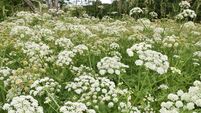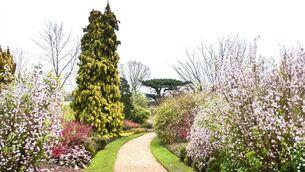Damien Enright: Even the animals are feeling right at home in Paradise

The temperature gauge in the Go Bus reads 21°C at 5pm as we are driven from Dublin Airport down the quays and along the Liffey to pick up more passengers for the three and half hour drive to Cork, writes .

It’s Thursday, April 19. We rose in Valle Gran Rey on the Canary island of La Gomera at 5am, took the new two-hour ferry trip from the remote side of Gomera to Tenerife port, then a taxi to the airport and a plane to Dublin. My wife’s work required her to be in Cork on the Saturday but no direct flight to Cork until Monday. With luck, we’ll reach home by 10pm tonight. A long day.
Now, it’s a beautiful evening, a beautiful Ireland, as we drive through the midlands, past fields speckled with crèches of newborn lambs with their mothers. How happy for them that they should be born into a world bathed in such glory.
In their innocence, they may believe it’s like this always, the blackbird calling, the gorse hedge golden at one end of the field, the blackthorns white at the other, the grass green and soft underfoot, the world bathed in yellow sunlight under a blue sky.
For now, they know nothing of rain or biting wind or miserable days of half darkness. They have been born into Paradise. Through all their three days of life, they’ve known nothing but love, if we can call the nuzzling, cosseting and suckling ewe sheep give their lambs, cows give their calves, mares, their foals, “love” — or should we deny the use of this word, so loaded with emotion, when referring to animals and the care they give their offspring?
We may declare “love” and “emotion” human responses. We may declare “mourning” a similarly exclusively human response, and yet there are countless instances of animals manifesting symptoms of grief, not only for fellow animals but for humans too, and these witnessed and attested to by animal behaviourists, scientists who have witnessed and studied them. If animals can “mourn”, can they not “love”? And cannot the lambs in the Irish field in the glorious sunlight experience paradise, a sense of exceptional wellbeing, a seminal part of which is “love”?
In the 1800s, Charles Darwin posited his belief that because of evolutionary connections between humans and other animals, many emotions would be similar across the species. However, after his death, the idea that animals could have emotions was gradually dismissed by the scientific community, and relegated to the realm of anthropomorphism, the stuff of children’s stories ( Peter Rabbit or Paddington Bear) or exemplary adult tales ( Aesop’s Fables), literary devices for entertainment or instruction. Giving animals human emotions was as fanciful as giving them human voices.
However, in recent decades, accounts from all parts of the world argue for a recognition of animal emotion and cognition deeper than that previously entertained.
Jane Godall, whose study of chimpanzees in Tanzania has become the longest continuous field study of any species on record, has recounted the heart-wrenching decline and death of a young chimpanzee from grief only weeks after the death of its mother. Dr Cynthia Moss, an internationally respected elephant ethologist, working in Kenya since 1968, has detailed the behaviour of elephants attending to dying comrades and ritualistically stroking the bones of dead relatives.
Also in Kenya, giraffes have been reported to gather at a ‘vigil’ for a dying calf, up to 17 at a time, attending for successive days. Dolphins have been reported to gather around and accompany a female supporting her dead calf in the Ionian Sea in Greece and, in 2016, biologists from the University of Milano-Bicocca published “a stunning report that described 14 responses of death in seven species of whales and dolphins, including clear evidence of mourning” (Scientific American magazine, Spring 2017)
Anecdotes from professional and amateur observers are legion. A growing body of evidence indicates that species ranging from domestic pets to great apes and marine mammals mourn the passing of relatives and close companions.
Meanwhile, at home in west Cork, I saw three swallows in our local skies on April 21. In the ravens’ nest on the cliffs, there are fledged young and, at home, the heron arrives each day voracious and with its curtain of breast feathers stained brown from sitting on a nest of young messy from regurgitated dinners.
The gorse is at its best, every flower open on the branches deep gold. Road verges are a riot of flowering dandelions. Chestnut foals stagger in green meadows on their stilts of legs, and black and white calves shake their tails as they burrow into their mothers’ udders.













